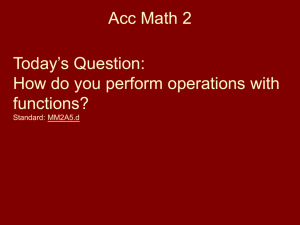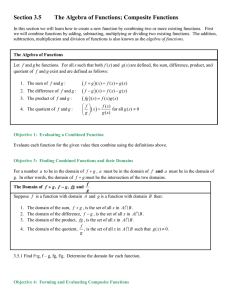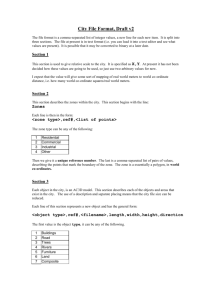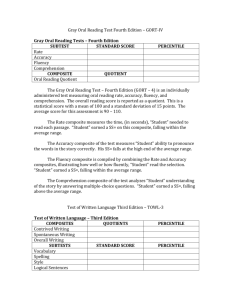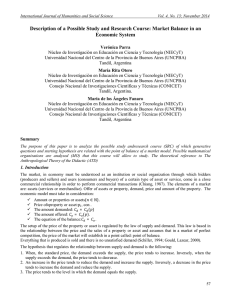Oct. 15 - William F. Lott
advertisement
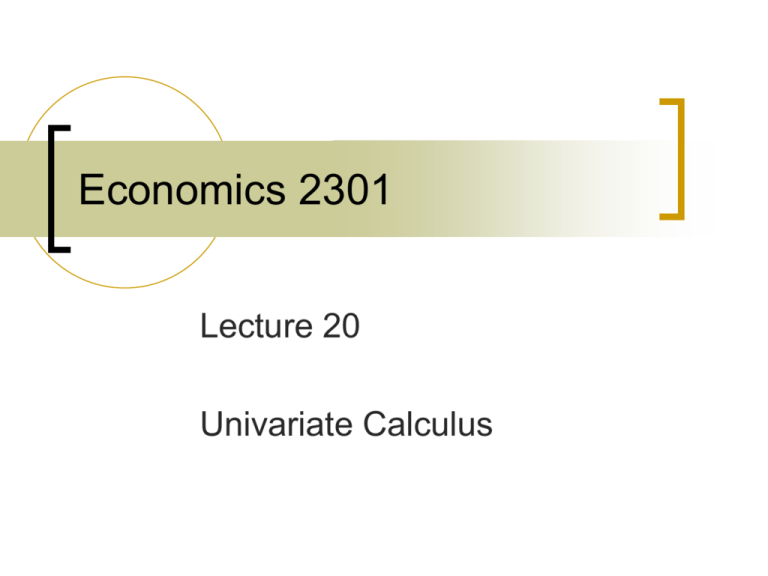
Economics 2301 Lecture 20 Univariate Calculus Chain Rule Many economic situations involve a chain of relationships that relate an ultimate outcome to its original cause. Money supply impact on output in Keynesian model. Chain rule shows how to evaluate a derivate when variable’s effect works through one function embedded in another. Composite Functions The chain rule shows how to differentiate composite functions, that is, functions in which the arguments are themselves functions. Let y=g(u) and u=h(x), then the composite function f(x) is y=g(h(x))=f(x). h(x) is the inside function and g(u) is the outside function. In general g(h(x))h(g(x)). Chain Rule The derivative of the composite function y f ( x) g (h( x)) where u h( x) and g (h( x)) g (u ) and both h(x) and g(u) are differenti able functions, is df ( x) g ' (h( x)) h' ( x) or dx dy dy du dx du dx Proof of Derivate of Exponential function Let y e f ( x ) , then dy f ' ( x )e f ( x ) dx proof : let u f ( x), then y e f ( x ) eu by chain rule dy dy du du eu eu f ' ( x) f ' ( x) e f ( x ) dx du dx dx Using this result, we get when y keax , dy a keax dx Example Chain Rule ye ( a bx cx 2 ) then dy d (a bx cx ) ( a bx cx 2 ) e dx dx 2 (b 2cx) e ( a bx cx 2 ) 2nd Example of Chain Rule Let y (5 3 x 2 x 2 ) 4 u 4 where u 5 3 x 2 x 2 dy dy du 4u 3 (3 4 x) 4 (3 4 x) (5 3 x 2 x 2 ) 3 dx du dx (12 16 x) (5 3 x 2 x 2 ) 3 General Power Rule For the function f(x) k h(x) n f ' ( x) k n h(x) n 1 h' ( x ) Example General Power Rule y 0.5 (0.5 x.5 0.5 x .5 ) 0.5 let h( x) 0.5 x.5 0.5 x .5 y 0.5 h( x) 0.5 dy .5 0.5 0.5 h( x) h' ( x) dx 0.5 0.5x (0.5) 0.5x 0.25x 0.25x 0.5 0.5 0.5 x.5 0.5 x .5 0.25 0.5 x.5 0.5 x .5 .5 .5 .5 .5 1.5 1.5 Quotient Rule g(x) is h(x) g ' ( x ) h( x ) h' ( x ) g ( x ) f ' ( x) h( x)2 proof : The derivative of f(x) let w( x) h( x) , then f ( x) g ( x) w( x) and f ' ( x) g ' ( x) w( x) g ( x) w' ( x) 1 w' ( x) 1 h( x) h' ( x) h' ( x) /h( x) Substituti ng in we get 2 2 f ' ( x) g ' ( x) w( x) g ( x) w' ( x) g ' ( x) / h( x) g ( x)h' ( x) /h( x) 2 g ' ( x ) h( x ) h' ( x ) g ( x ) h( x)2 QED Example of Quotient Rule y e3 x / x 2 dy 3e3 x x 2 2 xe3 x e3 x (3x 2 2 x) e3 x (3x 2) 2 4 3 2 dx x x x

